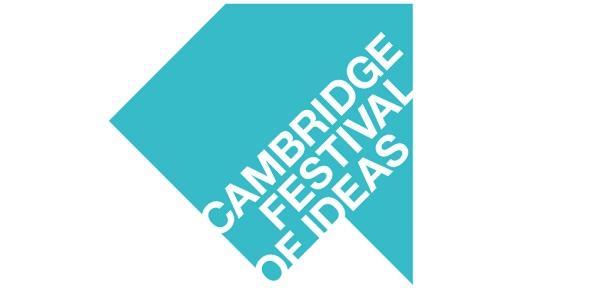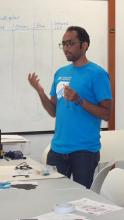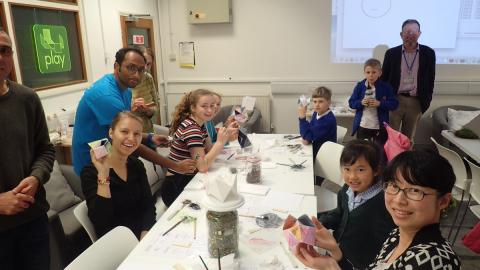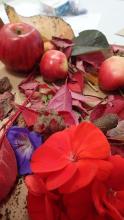
Submitted by Jenny Molloy on Thu, 02/11/2017 - 00:07
The Colour Institute brought a series of events about colour to Cambridge Makespace as part of the Festival of Ideas 2017. Featured activities included DIY pigment extraction, open source colorimeters and fantastic talks and demos from scientists, artists and writers.
The Colour Institute was co-founded by Sophie Weeks (Art and Science Soiree) and Dr Gareth Rees (Scott Polar Research Institute) and aims to bring together researchers from the arts, humanities and sciences who share an interest in colour to explore and extend the impact of research. They collaborated with the SynBio SRI to put on two events as part of the Festival of Ideas that explored the Festival theme of 'Truth'; in the context of colour perception - do our eyes deceive us?
Have you ever wondered, well I have.
About how when I say, say red, for example.
There's no way of knowing if red
Means the same thing in your head
As red means in my head. When someone says red.
- Matilda the Musical, Tim Minchin
 Our family event 'A sense of colour' on 17 October saw parents and children making DIY colour measuring machines designed by Praveen Teleti through the Biomaker Challenge and questioning how we sense colour. Our eyes tell us that the colour of real and fake grass is very similar but if we augment our eyes with machines and look at the infrared end of the colour spectrum they appear very different! We learnt about the chemistry and physics of colour and split white light apart with DIY spectrometers made from cardboard and blank CDs.
Our family event 'A sense of colour' on 17 October saw parents and children making DIY colour measuring machines designed by Praveen Teleti through the Biomaker Challenge and questioning how we sense colour. Our eyes tell us that the colour of real and fake grass is very similar but if we augment our eyes with machines and look at the infrared end of the colour spectrum they appear very different! We learnt about the chemistry and physics of colour and split white light apart with DIY spectrometers made from cardboard and blank CDs.
During the two sessions, participants met some 'colour makers' from the arts and sciences: Nabil Ali is an artist who researches natural pigment and ran a hands-on paint-making workshop using sources like indigo, madder, saffron and plants grown in his own back garden. Dr Edwige Mouyrod (Sainsbury Lab) and Rox Middleton (Department of Chemistry) introduced us the world of structural colour and iridescence.
We also had a beautiful exhibition of images by local artist The Microscope Man, Ben Dobson brightening up the walls of the newly refurbished classroom at Makespace, Cambridge's very own community inventing shed.

The Colour Institute Art & Science Soiree on 19 October brought together makers, writers, artists and scientists for talks on the use of colour in synthetic biology, scanning and printing works of art, remote sensing, the history of pigment and the use of colour in art. Activities and colourful surprises were provided, with the aim of inspiring creativity, fostering collaboration and interdisciplinary research.
Sophie Weeks and Gareth Rees began the evening with a light- hearted conversation exploring the arts and science of the colour white. Kassia St Clair then gave a selection of tales from her book 'The Secret Lives of Colour': from trade routes for ultramarine blue, 250,000 snails being harvested for tiny amounts of royal 'Tyrian purple' and a popular Victorian hue 'Scheele's Green', which turned out to be toxic as it was laced with arsenic!
Dr Jenny Molloy (SynBio SRI) described some of the ways in which biological organisms have evolved and used colour and the inspiring and sometimes extraordinary ways in which synthetic biologists now harness that as a tool for everything from understanding the development of living organisms to diagnosing arsenic contamination.
 Up next, Georges Charlier (Salto Ulbeek, Be) discussed colour in the printing and graphic design industry and the lengths he has gone to in digitising photo archives from Antarctic expeditions to ensure that their spectral properties are preserved. He has also invented a whole new colour system that could make printing more efficient and environmentally friendly. Dr Paola Ricciardi, Research Scientist at the Fitzwilliam Museum's colour lab gave a walk-through of some of the techniques she uses to analyse paintings, tapestries and other artefacts and her role in curating the exhibit 'COLOUR: The Art and Science of Illuminated Manuscripts'.
Up next, Georges Charlier (Salto Ulbeek, Be) discussed colour in the printing and graphic design industry and the lengths he has gone to in digitising photo archives from Antarctic expeditions to ensure that their spectral properties are preserved. He has also invented a whole new colour system that could make printing more efficient and environmentally friendly. Dr Paola Ricciardi, Research Scientist at the Fitzwilliam Museum's colour lab gave a walk-through of some of the techniques she uses to analyse paintings, tapestries and other artefacts and her role in curating the exhibit 'COLOUR: The Art and Science of Illuminated Manuscripts'.
Our flashing Xylobands (provided by their creator Jason Riegler and programmed by Jacob Butler from the Department of Physics) reminded us to talk to new people and share our collaborative ideas over colourful cocktails and canapes.
Everyone left feeling creative, inspired and having achieved at least one colour maker challenge as well as learning about the biology, chemistry, physics, history and aesthetics of colour in a truly interdisciplinary sense.
Thanks to all of the speakers, organisers and volunteers mentioned above, Barbara Nasto for providing a colour maker challenge, Alison Murray, Miguel Morin and many more cocktail and canape makers, greeters and hosts for their invaluable contributions to the events.

